Chana Masala
So I made Smitten Kitchen's chana masala last night and it was delicious but apparently my (new, fresh) cayenne is hotter than I thought. Oops.
In any event, a good excuse to have a beer with dinner, right?
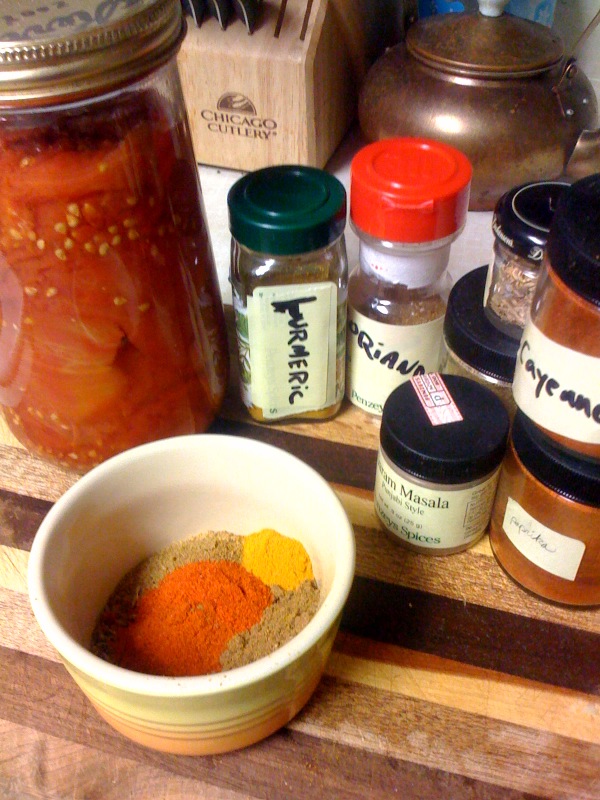

So I made Smitten Kitchen's chana masala last night and it was delicious but apparently my (new, fresh) cayenne is hotter than I thought. Oops.
In any event, a good excuse to have a beer with dinner, right?


Classic:
In the Internet age, David can go on Facebook to help him bring down Goliath.That's what happened in Morrisville, Vermont, where the tiny Rock Art Brewery, maker of Vermonster beer, marshaled a wave of public opinion to help in a lawsuit against Hansen Beverage, which sued for copyright infringement on their Monster Energy Drink.
In this action, Hansen violated a cardinal New England rule: Do not mess with Vermonters. They are well-insulated, wear generally supportive footwear, and are armed to the teeth. Last month, when Rock Art owner Matt Nadeau received a boilerplate "cease and desist" letter from Hansen Beverage, he told me, he decided not to take a simple action like putting an extra "t" in the name of his beer.
"I could do that," says Nadeau, then pauses. "Don't want to."
It was my favorite food mag, always inspiring, often thought-provoking. Their piece on modern-day slavery in Florida's tomato fields had tremendous impact on raising broad awareness of the issue - and likely helped the Coalition of Immokalee Workers gain some much needed traction in the media.
And the recipes, the recipes.. Sorry Bon Appetit, you can't compare.
Tom Philpott, spot-on as always, on the demise of Gourmet:
And this brings us to the real trend behind the Gourmet story: the power of axe-first, ask-later consultants in molding the media landscape in a time of crisis. For weeks now, according to various reports, grim-faced outsiders in suits have swarmed the Condé Nast offices. Employed by the consultancy McKinsey, their evident task is to scrutinize the books and hack away at anything not turning a profit.Yet in their search for maximum short-term profit and return on invested capital, they tend to be myopic, unable to see beyond the next quarter’s bottom-line prospects.
Sigh.
(via Grist)
This year, I'm putting a serious effort into my winter pantry. Fruits and veggies are getting put up as fast as the season brings them to harvest.
Tell ya what, it's a boatload of work, and I'm very aware of the privilege that allows me entire weekend days to sweat and hustle over hot water for 13 hours to put up food. It's not cheaper than shopping at the grocery store, not if you value your time, but it is tasty and it is fun.
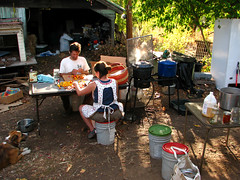
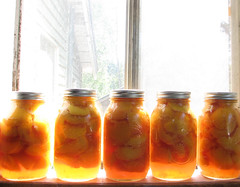


Photos: (1) Our canning workstation at small i, (2) peaches! (see that rise? not optimal, but not bad for novices), (3) field harvesting at small i, (4) a break to enjoy the sunset from Snowden
While I was on a 13-hour team canning odyssey with 100 lbs of peaches, my buddy BHB was out catching a steelhead:

Gorgeous fish. He was kind enough to bring a generous filet to our potluck last night, which we grilled alongside some blackberry BBQ ribs - and of course a groaning table of veggie sides, courtesy of my and my friends' gardens. I love potlucks. Hopefully will have a few photos soon.
Y'all, I made the most fabulous dinner the other night.
Before I subject you to vaguely obscene tomatoes and fluorescently lit gratineed potatoes, let me say something up front: much of the foodie world gets on my nerves. I'm a more about spending less time falling into paroxysms of glee over the PERFECTION!! of our GLORIOUS FOOD DISHES!! and more time enjoying good food - sustainably produced! - in good company. It's a free world and all, so you do what you want, but that stuff's not my style. I love food, I love farmers, I spend every working day doing local food systems work professionally. I cook pretty much every day. I rarely blog about it because I'm too busy, well, eating and living it.
But for all my high-horsery, I can be convinced upon occasion to talk about food HERE. See, the other day I heard about a contest. Throw a li'l Julia Child dinner shindig, blog about it, win fabulous prizes. I hereby swallow my indignant grumblings about adjective overuse and terrible indoor photographs and present to you:
Julia Child, Gorge Grown Style
ze menu:
Soupe au pistou (also spotted in the NYTimes and Gourmet this summer - Julia, you were ahead of your time on this one)
Baked cucumbers (wait, you can BAKE cucumbers?)
Gratin dauphinois (classic, reminds me of Paris)
Pork chops braised in fresh tomato sauce (well, I love pork.)
Cherry clafoutis (I do live in a cherry-producing region)
You can get some mighty fine raw ingredients here in the Gorge. To wit:
Pork from Mountain Shadow Natural Meats, Dufur, OR:
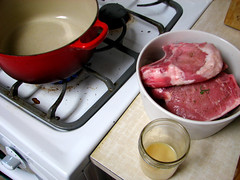
Potatoes from Raisin Hill Farm, Lyle, WA:
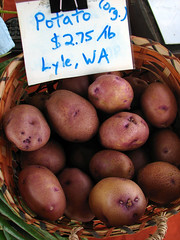
Carrots, green beans, cucumbers, and zucchini from MY GARDEN:
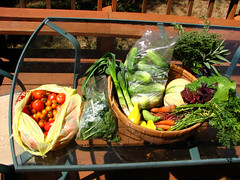
Cherries from Feeley's Fruit, Hood River, OR:
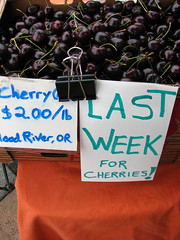
Slightly suggestive tomatoes from the Stevenson Mobile Farmers' Market:

So here's how it all went down. This is a pretty typical Sunday for me, multi-course dinner aside. I get up, I bust it in the garden, I go for a walk, I make some food, I spend time with good people.
I went out to my garden Sunday morning and tamed some mighty weeds. Got covered in dirt and had a good ol' time. I also harvested some of the goods.

I came back. I did a little PREP.
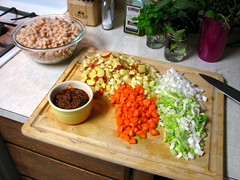

I took a little walk by the river to get some fresh air. Searing pork makes you smell like pork. A lot.

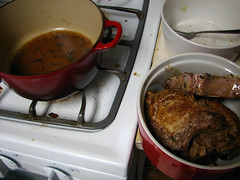
At this point I realized I had maybe spent a little too much time enjoying the garden and the river and not enough time getting all these courses ready. A triage decision was made to sub in a cold cucumber salad (a la Edna Lewis, so sorry Julia!) for the baked cukes - there was no time! No oven space! Ah!
Someday I will try that crazy baked cuke business.
In the meantime, the peeps arrived. Here are the men, being The Men. I'm pretty amused by this. I mean, really, the garage?
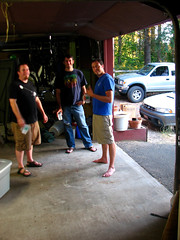
No photo of the ladies in the kitchen. Too busy being busy in the kitchen, of course.
We sat down, at dusk, my pictures are all blurry, but I can assure you we toasted and ate a ton and had a grand old time. Julia, you win. I hereby can happily report my renewed affection for and interest in both French cooking and the redoubtable Mrs. Child.
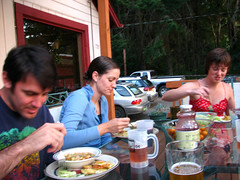

Yummers!

As promised, fluorescently lit photos of gratineed potatoes, you can thank me in the comments:
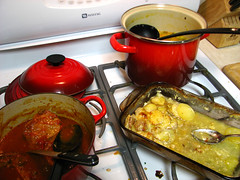
Things are wild and woolly at the garden these days:
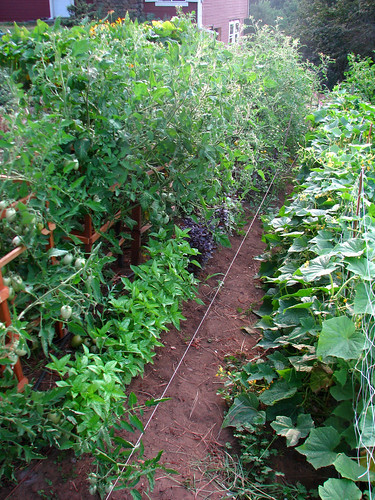
More to come..
For the record, the Lemon-Glazed Butter Cake in April's Gourmet was a real nice weeknight-super-quick dessert. Especially when topped with some of last year's strawberries cooked into sauce. Mmm.
This is just to say that I can wholeheartedly attest to the awesomeness of this recipe:
Pork Cheek and Black-Eyed Pea Chili
However, if, like me, your town don't sell no HOG JOWL (the less cool but more accurate Southern term for this cut of meat), a pork shoulder will work just fine. You might curse yourself for purchasing a bone-in cut as you wrestle to slice bloody drippy squishy flesh off the bone and into tidy chunks for soup, and you might question your lapsed vegetarianism as you deal with the mondo food safety hazard cleanup job your counter now requires, but the finished product will be fully worth it. Besides, bone-in means you can make stock too.
Tips: 1 or 2 pieces of bacon is more than enough. Carrots are a nice addition too. Don't forget to make cornbread to go with. I have a new cornbread go-to recipe and if anybody actually wants it maybe I'll post it. It's equally good with the soup and/or as dessert with honey and milk.
If you are lucky, you'll get to serve the chili to two of your good friends, and they'll stay for hours over great conversation, and you'll look at your watch and suddenly it's on its way to midnight, so you bid your goodnights and go to bed feeling better than you have in a long while.
Nice review of Bittman's new Food Matters.
With a colleague, Kerri Conan, Bittman devised a plan they called "vegan until six." They ate almost no animal products at all until dinnertime, no simple carbohydrates and no junk food. (Simple carbs are sugars, white flours and other processed grains like white rice.) At dinner, they ate as they had before, although in time Bittman found that even his evening meals came to include more "vegetables, fruits, legumes and whole grains and less meat, sugar, junk food, and overrefined carbohydrates." It was easy, and in a matter of months he'd lost 35 pounds, lowered his cholesterol and blood sugar, and had no trouble sleeping through the night. Most important, he continues to eat this way and is content to do so for the rest of his life.
A little less discussion of the more interesting angle -
Of all the challenges confronting the "Food Matters" plan for "responsible eating" -- agribusiness lobbying and marketing, the low price of subsidized junk food, even evolutionary factors that attract us to high-calorie foods -- probably the single most obdurate is the fact that so many contemporary Americans simply don't know how to cook. By "cook," I don't mean being able to concoct an impressive dinner the one night a month you have guests over while otherwise subsisting on nuked Lean Cuisine. Real home cooking means having a good repertoire of reliable, quick, uncomplicated recipes and understanding enough of the underlying principles to improvise when needed. It means knowing how to stock a pantry and plan your menus so that you shop for groceries only once a week. It's a set of skills manifested as an attitude, something you can acquire only through regular practice, and it's the one thing that can make a person truly at ease in a kitchen.
Yes, that is well and good, but how exactly do we go about this? Something we puzzle over frequently in the food circles, especially given the problematically paternal / patronizing attitude that is often present in classes for, say, low-income food stamp recipients. These folks aren't not cooking because they don't want to, they're not cooking because they've got a whole lotta other shit to worry about too.
Last week I got my jam on and made:
Green tomato preserves (from The Gift of Southern Awesome Cooking)
Green tomato and apple chutney (ditto, and strong enough to peel your eyeballs)
Spicy fig orange jam (from Simply Recipes
This is in addition to the golden raspberry and peach preserves I've already put up. And the bourbon peaches, and the peach-rhubarb chutney, and then of course all that tomato sauce...
Next up: apple butter, applesauce, and pumpkin butter.
Yes that is the first tomato from my garden. It was awesome. There are so, so, so many more on the vines to come. In addition to about 3290432 more lbs of zucchini that are coolin' in my fridge and more green beans than I can eat and so much more.
My garden is by far one of the best things in my life these days.
This list of official U.S. state beverages makes you wonder if maybe the milk lobby has been on some kind of decades-long campaign for the title in as many states as possible.
Or, as Pam said, "Bless you, Wisconsin."
Also - Go Maine! Moxie!
And Nebraska, are you kidding?
Foodstuffs prepared from scratch over the course of the weekend:
(bold denotes new recipe)
Raspberry-lemon muffins
Panang curry with peppers and tofu
Wilted spinach salad with bacon and green onions
Ambrosia (from Cross Creek Cookery, natch)*
Curried spinach-pea soup
Lemon-orange pie**
In addition to cleaning my ROOM (pictures forthcoming), finishing Eat Pray Love (mixed feelings), editing my boatload of Seattle/Punch Brothers/Wintergrass photos (forthcoming), and spending most of Sunday xc-skiing - and face-planting - on some more advanced trails under a glorious blue sky (pictures DEFINITELY forthcoming).
* The post office has Marjorie Kinnan Rawlings stamps right now! I am stocking UP!
** My tart take on Key lime pie, made with a surplus of lemons and a bit of orange zest. Thinking of upping the orange vibe and adding a bit of orange blossom water next time...
Not that this is new news to those of us who work in the local food movement, but this piece in the NYTimes raises a few sticky questions:
Here are a couple of other puzzlers: Are canned tomatoes a better environmental choice in the winter than fresh tomatoes from abroad? If a product that contains heavy packaging reduces the amount of food waste, is that a better choice than one that is lightly packed and spoils quicker?
And there's so many more - does a carton of strawberries driven 20 miles in a gas-guzzler old pickup truck have a smaller or larger carbon footprint than a carton of strawberries flown or trucked in from hundreds of miles away? If you drive to the farmers' market in your car, do you negate all of the benefits of buying local? How is anybody supposed to be able to make the 'right' decision at the grocery store?
At some point, the ethical maze can make you dizzy. But there was one line of inquiry from the California researchers that hit particularly close to home: the carbon impact of shoppers themselves.Some people walk or take the subway to buy their groceries and then compost what they don’t use. But, let’s face it, most of us drive and toss the leftovers into the garbage disposal or the garbage can. In doing so, we may be contributing nearly a quarter of the greenhouse gases associated with our food, research has shown.
Ouch.
I'm interested to see the final results from the research that's described in this article. I and a lot of other people across the country are putting a lot of time and energy into re-localizing food systems, and we damn well want to make sure we do it right and don't cause more problems than we solve.
Might have finally perfected my kale soup recipe. Such a good fall soup. Recipe forthcoming.
It was a good weekend. Impromptu dinner party with giant pot of soup, bread, pear cake, salad with pomegranates, wine, beer, and neighbors. A country contradance at the grange hall. Beers at the Pourhouse. A waterfall hike. An unexpectedly sunny day and a few hours to read on a sunny rock above the big blue Columbia. A gut-busting tasty breakfast in town. (T: excellent 'cakes, but not quite WASP's) Sunday morning 10 Speed Coffee, quickly becoming tradition.
I definitely need to read this book:
The concerns of food production companies have ramifications far beyond what appears on supermarket shelves. Their concerns are the rot at the core of the modern food system. To show thesystemic ability of a few to impact the health of the many demands a global investigation, travelling from the ‘green deserts’ of Brazil to the architecture of the modern city, and moving through history from the time of the first domesticated plants to the Battle of Seattle. It’s an enquiry that uncovers the real reasons for famine in Asia and Africa, why there is a worldwide epidemic of farmer suicides, why we don’t know what’s in our food any more, why black people in the United States are more likely to be overweight than white, why there are cowboys in South Central Los Angeles, and how the world’s largest social movement is discovering ways, large and small, for us to think about, and live differently with, food.
From the intro to Stuffed and Starved, by Raj Patel. (via Critical Mass, thanks Pam)
You can never go wrong serving a guy homemade garlic bread.
It is officially summertime. Know what I need in my life? Campari.
Not only because I could make a light fixture like this:

... but because a Negroni is one excellent summertime cocktail.
What else is excellent in the summertime?
Friday: Jackson, WY
Saturday: Yellowstone
Sunday: Grand Teton
Monday: Craters of the Moon
Tuesday: work by day, Boise by night
Wednesday: work by morning, parents + thrift shopping by day, skinnydipper hot springs by moonlight
It's been a busy week.
So I know I graduated almost a year ago already but I still do graphic design for the Farm to Dartmouth project 'cause I'm cool like that - and they're havin' this kickass local foods expo today and I made the poster and it's way sweet so you should totally check it out.
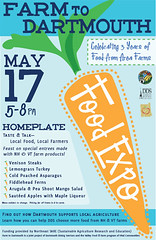
Guess who's on cook duty for next weekend's float trip down the John Day River?
I'll get to inaugurate my new (v. old, has great backstory) 15-inch mega camp iron skillet, too, since there'll be 13 friends to feed! But before all the fun stuff happens, I've got to do the food shopping. Some collaborative menu planning with the other hazards girls has given us a (mostly) awesome plan for the weekend. Though let me tell you that I miss Cabot cheese something terrible. This Tillamook business just. does. not. cut. it. (ha)
But.
Why do people insist on putting peanut butter into all kinds of dishes into which it is not welcome? For that matter, who needs it at all? Jelly and cheese sandwiches for all! Curry without that heavy peanutty underbelly! Trail mix without all those dang peanuts!
That aside, i'm getting excited for this trip. This coming weekend is pretty slow, which may in fact be a good thing, given the pending Big Awesome that will the the John Day.
True that.
It’s come to my attention that some people believe martinis are made with vodka. I hate to get snobbish about it, but a martini should be made with gin or it’s not a martini. Call it a vodkatini if you must, but not a martini. Gin and vodka have as much in common hierarchically as a president and a vice president. Vodka can fill in for gin from time to time and might even be given certain ceremonial duties of its own, but at important moments you need the real thing. Vodka generally makes a poor substitute for gin in a martini or any other gin cocktail.The panel found common ground here. Each of us is partial to the classic martini made with gin, although Audrey was sensitive to the desires of her clientele.
“You have to revisit which generation is drinking the martini,” she said. “We might be classicists, but is the newer generation?”
Still, after perhaps 8 or 10 martinis, Audrey fessed up, referring at one point to “a generation lobotomized by vodka.”
Since I'm, uh, pretty much livin' the Food Stamp Challenge every week out here in the poorest county in Oregon, I was glad to see some NYTimes coverage yesterday on Oregon Governor Ted Kulongoski's participation in the Oregon Food Bank's Food Stamp Challenge - he and his wife ate for a week on $21 each, the average amount an individual receives in federal food stamp benefits. That's $3 a day.
Mr. Kulongoski has made hunger an issue since he was first elected in 2002. That fall, he said in an interview, he was surprised to learn that Oregon ranked high on the list of what the Department of Agriculture used to call hunger and now calls “food insecurity.” Oregon’s timber and agricultural industries had long been struggling, driving up unemployment, and the high-tech boom that had benefited places like Portland had started to unravel.
I've been very impressed with the Oregon Food Bank and the food security work that's being done on a state and local level, and there is indeed a real need for programs like food stamps and food pantries: in Ontario, a town of only 11,000 residents, one food pantry alone serves over 1,000 residents a month. That's not even counting several smaller pantries and partnerships for distribution through human services nonprofits.
Which reminds me - if any of y'all have any super-easy, super-cheap tofu recipes, drop me a line. I'm working with the local food bank to develop some easy, cheap, kid-friendly ways to use tofu that we can demo at the food pantries using products available there; the warehouse frequently gets donated tofu and many people are leery of eating it. (in development currently: tofu lasagna, tofu chocolate mousse, tofu smoothies, and a few others)
I'm not Catholic, but I think that I should give up potato chips for Lent. It's been, uh, getting out of hand.
I don't know how I feel about the fact that the New York Times has a feature piece up on red velvet cake.
Especially with a lede like this:
IT’S a cake that can stop traffic. The layers are an improbable red that can vary from a fluorescent pink to a dark ruddy mahogany. The color, often enhanced by buckets of food coloring, becomes even more eye-catching set against clouds of snowy icing, like a slash of glossy lipstick framed by platinum blond curls. Even the name has a vampy allure: red velvet.
Sheesh. Why is most food writing so bad?
That said, I kinda do want to try their recipe.
Don't these sound enticing? Next time I visit a real city I'm going to pick one to buy. I love me some Hendrick's but I really really really want to try Bluecoat (from Philly, not on this list, really hard to find) and Aviation.
Aviation: Lavender notes come through strongly alongside juniper, cardamom and a faint hint of almond.Broker's: Traditional and no-nonsense, with up-front juniper, high complexity and intensely dry backbone.
Bulldog: Fresh lemon zest leads the way, and it's followed closely by ginger, but there's very little juniper here, and the spirit is rather soft for a London dry gin.
DH Krahn: Heavy coriander notes dominate this gin. They're balanced with a high-note of ginger and citrus.
Gin No. 209: Highly perfumed with juniper taking the lead and complex floral notes following closely behind.
G'Vine: Floral, grassy, spicy and smooth. There's an unusual sweet/dry earthy thing going on in this one.
Old Raj: Juniper takes the lead here, but it's swiftly followed by a distinct burst of saffron and a nutty, spicy backdrop.
Sarticious: A strange gin, indeed, though it's very well crafted. The herbaceous qualities in Sarticious are reminiscent of, wait for it, Tequila. Probably has something to do with the cilantro in the botanicals. This is a must-try-it-at-least-once gin.
Tanqueray Rangpur: Limes dominate in this bottling, and they play well off spicy ginger and a host of other, more subtle botanicals.
(From SFGate)
Today I began the process of making lemon marmalade with an armful of lemons from the big washtub full we've got out back.
We made pralines today too, two batches, so delicious.
And tonight there's boniato, a tropical sweet potato, with coconut milk and nutmeg.
I owe y'all some food posts!
I've been cooking without recipes a lot lately - just kinda messing around with ingredients and tossing things together. A whiskeyed apple galette, quinoa stew, various salads, roasted this-and-that. Nothing fancy, but lots of good solid dishes. The biggest success, though, was an experiment with collard greens.
Being disinclined to smell greens boiling in pork fat all day on Sunday (the traditional method), I set off through my freezer and spice jars for ideas.
What I came up with:
1 bunch collard greens
1 small yellow onion
1-2 andouille sausages
4 cups chicken broth
red pepper flakes
Cajun spices (Penzey's makes a nice mix; you can also make your own - cayenne, chili, paprika, onion, mustard, cloves, and sometimes some other fragrant bits too)
You don't really need an exact recipe for this if you've cooked collards before. Just chop 'em up, toss 'em in the pot (or slow cooker) with the liquid and onions, let it cook 'til the greens are tender and the onions translucent, add the sausage and spices, and cook it some more. It can cook 'til it reaches your desired tenderness - my family cooks them the Southern way, which is "down to mush". When I'm cooking for myself I go for a slightly less pulped version.
Don't forget the cornbread on the side - and to make it a more complete meal, you can bake some accompanying sweet potatoes too.
Oh you guys. So for Thanksgiving I've been assigned to make a pecan pie.
Now, I've made pecan pie before. I have several recipes. But I made the mistake of thinking I'll do a little Googling to compare recipes this evening.
It's 2 hours later I'm still looking at pecan pie recipes. The thought of cane syrup, corn syrup, golden syrup, maple syrup, honey, or brown sugar is more than a little nauseating.
I've saved no less than 7 variations that all sound appealing - at least they did a little while ago. That's just the ones that differ from the recipes I already have. My Lord.
If I have great success with my pie on Thursday I'll post the winning recipe. I need to post my chili recipe from the other day, too. I need to remember that one, 'cause it was awesome.
P.S. Totally unrelated, but - sometimes I really wish I'd done more stupid and crazy things when I was still a minor. It's kind of awkward to be making up ground at 22. Better late than never, I suppose...
Not too crazy about the term food evangelist. But, uh, if you ever wanna know about the food shed, hit me up.
For food evangelists — consumers who might shop at a co-op or who can explain terms like eco-gastronomy, food miles and the food shed — a local label is sometimes more important than an organic one. That group, which market researchers say make up about 10 to 15 percent of food shoppers, are most likely to spend time in the store pondering whether an organic pepper from Chile is better than one grown in a nonorganic field less than 250 miles away.
(from here)
I'm making pumpkin chili in the slow-cooker today for dinner. It means that at 7 am I smelled like onions and garlic and pumpkin. But I'm ok with that, because when I get home, my chili will be ready!
If it tuns out tasty I'll post the recipe.
A few lessons learned from yesterday's marathon cooking and baking session:
1) Scones get way fluffier and (somewhat inexplicably) more tender when you roll out the dough, fold it, roll it, fold it again - like biscuits. I was always certain that this would make my scones tough. However, a scientific experiment in the name of finding-a-better-scone (mine have never been very good, sadly, though they are my Great Love) has given unquestionable proof that scones will rise higher and have superior texture if they are prepared in the roll-fold-roll-fold-roll-cut-bake method instead of the lazy roll-cut-bake. Never will I eat roll-cut-bake bricks again.
2) No matter how rushed you may be to remove your loaf of bread from the loaf pan, LET IT COOL A BIT. Otherwise you'll rip a chunk out of the bottom, which will taste delightful but render the loaf unusable for sandwich slices.
3) If you freeze your entire pound of ground buffalo meat, it will be very difficult to separate half of it out for chili. Think about this before you freeze it. Package it in portion-size chunks so that next time you will not need to take a hammer and chisel to the frozen meat.
4) Just because cooking makes you less hungry and inclined to forget to eat actual meals, don't forget to eat and then run out to do an hour's worth of errands. You will guaranteedly find yourself starving in the midst of it.
I'm a big Michael Pollan fan. In case you haven't read his piece in the NYT yet, here are a few excerpts for you (and some of my thoughts below them):
Wendell Berry once wrote that when we took animals off farms and put them onto feedlots, we had, in effect, taken an old solution — the one where crops feed animals and animals’ waste feeds crops — and neatly divided it into two new problems: a fertility problem on the farm, and a pollution problem on the feedlot. Rather than return to that elegant solution, however, industrial agriculture came up with a technological fix for the first problem — chemical fertilizers on the farm. As yet, there is no good fix for the second problem, unless you count irradiation and Haccp plans and overcooking your burgers and, now, staying away from spinach. All of these solutions treat E. coli 0157:H7 as an unavoidable fact of life rather than what it is: a fact of industrial agriculture.But if industrial farming gave us this bug, it is industrial eating that has spread it far and wide. We don’t yet know exactly what happened in the case of the spinach washed and packed by Natural Selection Foods, whether it was contaminated in the field or in the processing plant or if perhaps the sealed bags made a trivial contamination worse. But we do know that a great deal of spinach from a great many fields gets mixed together in the water at that plant, giving microbes from a single field an opportunity to contaminate a vast amount of food. The plant in question washes 26 million servings of salad every week. In effect, we’re washing the whole nation’s salad in one big sink.
It’s conceivable the same problem could occur in your own kitchen sink or on a single farm. Food poisoning has always been with us, but not until we started processing all our food in such a small number of “kitchens” did the potential for nationwide outbreaks exist.
Surely this points to one of the great advantages of a decentralized food system: when things go wrong, as they sooner or later will, fewer people are affected and, just as important, the problem can be more easily traced to its source and contained. A long and complicated food chain, in which food from all over the countryside is gathered together in one place to be processed and then distributed all over the country to be eaten, can be impressively efficient, but by its very nature it is a food chain devilishly hard to follow and to fix.
[...]
These days, when people make the case for buying local food, they often talk about things like keeping farmers in our communities and eating fresh food in season, at the peak of its flavor. We like what’s going on at the farmers’ market — how country meets city, how children learn that a carrot is not a glossy orange bullet that comes in a bag but is actually a root; how we get to taste unfamiliar flavors and even, in some sense, reconnect through these foods and their growers to the natural world. Stack all this up against the convenience and price of supermarket food, though, and it can sound a little. . .sentimental.
But there’s nothing sentimental about local food — indeed, the reasons to support local food economies could not be any more hardheaded or pragmatic. Our highly centralized food economy is a dangerously precarious system, vulnerable to accidental — and deliberate — contamination. This is something the government understands better than most of us eaters. When Tommy Thompson retired from the Department of Health and Human Services in 2004, he said something chilling at his farewell news conference: “For the life of me, I cannot understand why the terrorists have not attacked our food supply, because it is so easy to do.” The reason it is so easy to do was laid out in a 2003 G.A.O. report to Congress on bioterrorism. “The high concentration of our livestock industry and the centralized nature of our food-processing industry” make them “vulnerable to terrorist attack.” Today 80 percent of America’s beef is slaughtered by four companies, 75 percent of the precut salads are processed by two and 30 percent of the milk by just one company. Keeping local food economies healthy — and at the moment they are thriving — is a matter not of sentiment but of critical importance to the national security and the public health, as well as to reducing our dependence on foreign sources of energy.
The thing that I like about this piece is that it's level-headed, information-dense, and highly readable. Heck, that's why I like Pollan in general. This is the kind of piece that I could print out and give to my co-workers, wives of ranchers and farmers, without fearing being labeled a sentimental hippy or insufferable food snob. I'm totally both of those in my personal time, but when you're talking food policy, you need a different approach. Pollan's logic in this piece is simple and easy to follow. He links facts together in ways that lead the reader toward a conclusion that seems reasonable and grounded in common sense. He doesn't take cheap shots and he doesn't overreach. He doesn't confuse local food advocacy for local food adulation.
First, the I'm-really-excited yell: YAAAAAAAAAAAAAAAAAAAAAAAAAAAAAAAAAY!
So today was a day out. I got up early (actually I overslept, but it was still early) and hit the road for Idaho. First stop: the Nampa Farmer's Market.
Nampa is a growing town about halfway between Ontario and Boise (it's something like 55 miles to B from O) and I knew nothing else about it. Turns out it's got a serious problem with suburban sprawl and the classic conflict between new folks and long-time residents who were used to a more stable, small town. Nonetheless the downtown is lovely and the market was fantastic and low-key.
Sweet deals:
Heirloom tomatoes 2/$1
Carrots $1/bunch
Parsnips $1/bunch
Pumpkin chocolate chip cookies 4/$1
Strawberries $1.75/half-pint
Honeycrisps $1/lb
Sugarplums $1/lb
Baby squash 8/$1
husk cherries $2/pint
Bag of chocolate maté $3
Sometime around here my bags got too heavy and I had to go to the car. Also I had to save some of my, uh, limited cash for the Boise market. So the produce was good. But the best thing? Meeting this awesome farmer lady who cultivates a half-acre in Parma, Idaho: we chatted for a while about vegetables, and farming, and markets, and contradancing, and talked about the possibility of my helping out next growing season with vegetables as payment (and perhaps a small growing plot of my own!). This is pretty much the best thing ever. Also, I got her business card and looked up her website and it turns out she's a renowned BEE EXPERT (with a Harvard Ph.d). You can't get much awesomer than that in my book. I can even forgive the Harvard affiliation.
So I left that market feeling just skippy. I then drove on to Boise to find that market. I found it alright, and it was a total zoo. Busy busy busy, not the kind of place to talk to people. There was some lovely produce, of course, and a farm called Peaceful Belly, which I thought was a lovely (and yes, seriously hippyish) name. I found more dirt-cheap tomatoes - BRANDYWINES for $1 each! I bought several. Guess who's making tomato sauce tomorrow? And pretty much eating tomatoes all next week? I win. Got some mizuna and heirloom pears and a new green mug too. Now if you come to visit me you can choose between my pottery mug collection and my beer glasses. I'm getting into drinking out of my beer glasses all the time. Forcefully resisted the absolutely dreamy breads, because Ima make my own tomorrow. Sunday is for baking and cooking.
On the list for tomorrow's cookery (to supply me for the coming week):
2 loaves of bread (wheaty somethingorother)
dorset scones
feta-and-chard turnovers
quinoa chard chowder
buffalo black bean chili (maybe, if I get the crock-pot going)
OH it will be great. And OH I've gotten off track. Anyway. I left the market and went to Renewal, which is a hip consignment furniture boutique. Lots of amazing stuff. No good desks for me. Almost bought a huge wool woven rug, kinda funky pattern, for my bedroom. Quailed on price tag ($150) but am still kinda considering it. It's really unusual and lovely. Lots of pinks and reds and warm blue tones.
Next up: my new gold standard for grocery stores: the Boise Co-Op. Seriously guys. This place blows the Hanover Co-Op just out of the water (though I still love that place!). They have 4 different kinds of bulk sea salt. I navigated my cart through a sea of slender blonde Boise women on cell phones and teenage-ish hippies and older, slightly-overwhelmed looking men with lists to get the stuff I'd written down to buy:
Milk
White Rice
Fruit
And then I just went hog wild. Spent all of my food stamp allotment in one fell swoop. Boom. I won't need groceries for weeks. Some of my most exciting booty:
Fresh carrot juice
Dried gooseberries
Organic molasses
Bensdorp cocoa (full fat, yeahhh)
Miniature kiwi fruit (the size of grapes!)
San Marzanos
Lots of other more mundane but fabulous stuff
AND the biggest tub of yogurt you have ever seen in your life, guaranteed. 4 lbs of it. Looks like the biggest one you see here:

"Billions of healthy bacteria in every teaspoon"!!!
I left that place feeling giddy. I love grocery shopping. Then I drove out to TJ Maxx to contemplate another rug (and grab a few discount airtight plastic tubs for my growing baking-supplies collection). I blasted the car's A/C on high for the whole way there, the better to keep it cool while I was in TJ Maxx. Wouldn't want the chard to wilt. I got out of the car, dusted off some ice crystals, and went in and bought the rug. Only spent approximately 3 minutes looking at sweaters. I have some serious self-control.
Hauled the rug to the car, took off for home, tired after a full day. Put the rug down at home - turns out it doesn't help the carpet as much as I'd hoped (it's not as big as the entire floor). Bother. I still like it though. Will post a picture sometime soonish. Since it was warm and sunny I then lounged in the park (2 blocks away!) and watched kiddies on the playground while reading a book. It's kind of an embarrassing book so I am not going to tell you what it is. I mean, it's not that bad, just a little cheesy and escapist, but still.
Am now very tired. Tomorrow I'm going out to my boss's storage warehouse to look at some dish sets and cookware that he has and might sell me cheap. This would be nice, as right now I have 1 bowl and 1 teacup saucer as dishes (plus my beer glasses and mugs). Would like to add to the collection. Unless you fancy soup in a beer glass... ?
My inaugural attempt at making Fred Bread was a delicious success. Crusty on the outside, soft and light on the inside. Whole-wheat. Ate almost half of the dang thing before I forced myself to bundle it up for the freezer.
As Kate says, "the whole idea is to make bread without losing time to read your book."
(Thx to THB for the recipe.)
Salon interviews author David Kamp, who does his best to reassure elitist foodies that local, organic food is the food of the PEOPLE! I'm sorry, but I don't see hordes of poor people lining up at the farmer's market to try that radicchio that the rich folks eat.
Those movements did start with an educated, worldly crowd -- with Alice Waters' Chez Panisse in Berkeley and Julia Child in Cambridge, Mass. But they have grown out of their origins. Organic food is no longer just for smug people in Northern California. I see moms in small towns buy Horizon milk because they don't want their children drinking industrial milk containing antibiotics and hormones.These things may have elite origins, but so what? They eventually spread out and have resonance across the country. I think that's true of so many movements, like in art and in fashion. Most fashions start with the most elite people on the planet and the average American can't wait to imitate them. But when it comes to food, we throw a fit. We've got to let go of that.
Clearly there aren't any problems with people imitating the airbrushed, skeletal fashion elite.
You won't find anyone more enthusiastic than me about the possibility of restructuring the entire American food system and culture around more local and organic lines. And I do agree that it's on its way. We're making unbelievable progress. But he brushes off what will be the biggest challenge of this movement - making this kind of food accessible to people of all incomes. The entire movement has been until now built by and for elites. Kamp seems to think that the benefits of this system will just naturally trickle down to everyone. Uh-huh. Lovely puff pieces glorifying Craig Claiborne and Alice Waters are nice, but can we please get over the fetishization of local/organic high cuisine and onto getting good food for everyone?
Salon had a better piece about Michael Pollan's new book, at least. Look how much more articlate and thoughtful he is about the same issue:
Yes, but I think most people could afford to spend more money on food in this country. There is a segment of the population, probably less than 10 percent, that can't spend more than they're spending now. And we need to help those people by designing food aid that points them to the produce aisle and away from the snack food aisle. But say we already help that 10 percent to feed themselves in healthier ways, the other 90 percent are spending less on food, as a percentage of income, than any people in the history of mankind. We spend 9 percent of our income on food, which is less than we spent 10 years ago or 20 years ago. If we could get that up a few percentage points, we could build a much more sustainable food system. So I think people just have to dig down in their pockets and spend more for food. We seem to be able to afford spending $50 to $100 a month on television and cellphones. I'm not saying people shouldn't have cellphones or pay television, but that it's finally a decision about what you value. And the elitism charge is often used simply to defend bad practices. I'm dubious about any situation where McDonald's can occupy the moral high ground.But it's more than an issue of money, isn't it? I know plenty of people who would love to buy and prepare fresh, local food more often but don't feel that they have the leisure time.
It's true. That is an issue. It does take more time to eat well. People have to spend more time choosing what they buy and they have to reacquaint themselves with the kitchen. It's odd, to judge by the Food Network and the fame of chefs and the popularity of Viking stoves, we're obsessed with cooking in this society, yet we don't really cook anymore. Cooking has become more of a ritual than a habit -- a high ritual that happens once a month. But it's true that to get off of processed food, you might have to join a CSA [community-supported agriculture program], where you get a box of produce every week and you have to figure out what to do with all that chard or butternut squash. And a lot of people don't feel they have time for that, partly because of the $50 to $100 they're paying for cable television and the Internet. Again, it's a matter of priorities. The good news is that there's a great deal of interest in eating whole foods. Farmers markets are appearing and thriving all over the country. And there's a movement taking shape to source school food and other institutional food locally, which could make a huge difference given that we eat half of our meals away from home. The one upside to having a monopolized food system is that a single company can make a dramatic difference. When McDonald's got out of selling genetically modified French fries, that product disappeared in a year. I was once told -- though I couldn't confirm this -- that if McDonald's gets just 25 unorganized calls or letters on a particular customer concern, the matter will get on the agenda at a board meeting. And I think that that's exactly what happened with genetically modified potatoes.
Anybody ever had a Blue Moon with an orange slice in it? Turns out it's pretty fantastic.
Delicious foods eaten on this trip so far:
Fratelli's, Portland
- Cracked pepper and sea salt-crusted coho salmon over roasted green rhubarb, with a tomato and some-crisp-and-tasty-vegetable coulis
- Buttermilk panna cotta with fresh berries and a tarragon-and-berry granite
Farmer's Mkt
- huckleberries
- honey+honeycomb
- pain au chocolat
The Keystone Cafe
- eggs 'n' homefries 'n' spelt toast (all organic happy free range etc)
Tom's house (dinner party!)
- grilled prosciutto-wrapped figs
- cheese + homemade bread
- salmon corn chowda (me an' T made this)
- tomatoes with basil and vinaigrette
- warm cous cous salad
- grilled Italian sweet peppers and onions with flank steak
- grilled garlic-rubbed bread
- cornmeal shortcakes with strawberries and fresh whipped cream
Miscellaneous Deliciousesses
- bumbleberry turnover
- potato donut (!)
- goji berries
- Blue Sky grapefruit soda
- some fruit leathers
- raisin walnut bread
- several hunks of a very nice 75% dark chocolate bar